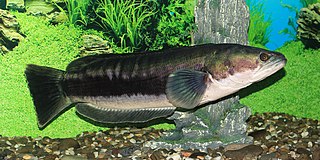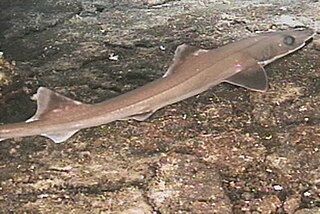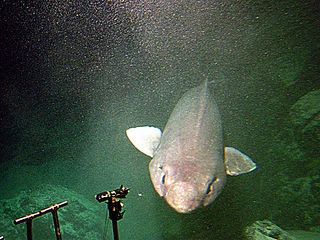
Cirrhitidae, the hawkfishes, are a family of marine ray-finned fishes found in tropical seas and which are associated with coral reefs.

The northern snakehead is a species of snakehead fish native to temperate East Asia, in China, Russia, North Korea, and South Korea. Their natural range goes from the Amur River watershed in Siberia and Manchuria down to Hainan. It is an important food fish and one of the most cultivated in its native region, with an estimated 500 short tons (450 t) produced every year in China and Korea alone. Due to this, the northern snakehead has been exported throughout the world and has managed to establish non-native populations in Central Asia and North America. In the United States, it is found in Pennsylvania, Virginia, West Virginia, Delaware, Maryland, North Carolina, Arkansas and Mississippi.

Channa is a genus of predatory fish in the family Channidae, commonly known as snakeheads, native to freshwater habitats in Asia. This genus contains about 50 scientifically described species. The genus has a wide natural distribution extending from Iraq in the west, to Indonesia and China in the east, and parts of Siberia in the Far East. A particularly high richness of species exists in Myanmar (Burma) and northeastern India, and many Channa species live nowhere else. In contrast, a few widespread species have been introduced to several regions outside their natural range, where they often become invasive. The large and medium-sized Channa species are among the most common staple food fish in several Asian countries, and they are extensively cultured. Apart from their importance as a food fish, snakeheads are consumed in some regions as a traditional medicine for wound healing and reducing postoperative pain and discomfort, and collected for the international aquarium pet trade.

The snakeheads are members of the freshwater perciform fish family Channidae, native to parts of Africa and Asia. These elongated, predatory fish are distinguished by their long dorsal fins, large mouths, and shiny teeth. They breathe air with gills, which allows them to migrate short distances over land. They have suprabranchial organs, which are primitive forms of labyrinth organs, that develop when they grow older. The two extant genera are Channa in Asia and Parachanna in Africa, consisting of more than 50 species.

Dwarf snakehead is a term coined by aquarists to describe a group of Channa snakehead fishes growing to about 25 cm (10 in) maximum. They are found in freshwater habitats in South and Southeast Asia, and southern China.

Channa striata, the striped snakehead, is a species of snakehead fish. It is also known as the common snakehead, chevron snakehead, or snakehead murrel and generally referred simply as mudfish. It is native to South and Southeast Asia, and has been introduced to some Pacific Islands. Reports from Madagascar and Hawaii are misidentifications of C. maculata.

Amphibious fish are fish that are able to leave water for extended periods of time. About 11 distantly related genera of fish are considered amphibious. This suggests that many fish genera independently evolved amphibious traits, a process known as convergent evolution. These fish use a range of methods for land movement, such as lateral undulation, tripod-like walking, and jumping. Many of these methods of locomotion incorporate multiple combinations of pectoral-, pelvic-, and tail-fin movement.

The slender smooth-hound or gollumshark is a species of ground shark in the family Pseudotriakidae. It is endemic to the waters around New Zealand, where it is usually found close to the bottom over the continental slope at depths of 300–600 m (980–1,970 ft). An extremely slim, plain brownish shark reaching 1.1 m (3.6 ft) in length, the slender smooth-hound can be identified by its broad, flattened head with a long, distinctively bell-shaped snout. Its mouth is angular with short furrows at the corners, and contains a very high number of tooth rows in both jaws. Its two dorsal fins are roughly equal in size.

The false catshark or sofa shark is a species of ground shark in the family Pseudotriakidae, and the sole member of its genus. It has a worldwide distribution, and has most commonly been recorded close to the bottom over continental and insular slopes, at depths of 500–1,400 m (1,600–4,600 ft). Reaching 3.0 m (9.8 ft) in length, this heavy-bodied shark can be readily identified by its elongated, keel-like first dorsal fin. It has long, narrow eyes and a large mouth filled with numerous tiny teeth. It is usually dark brown in color, though a few are light gray.

Channa micropeltes, giant snakehead, giant mudfish or toman harimau, is among the largest species in the family Channidae, capable of growing to 1.3 m (4.3 ft) in length and a weight of 20 kg (44 lb). It is native to the fresh waters of Southeast Asia, but has also been introduced elsewhere and is considered invasive in Taiwan. Other names include shol machh in Bengali, red snakehead, redline snakehead, and ikan toman.

Gollum is a genus of ground sharks in the family Pseudotriakidae, native to the southwestern Pacific Ocean. The genus was described in 1973 by biologist Leonard Compagno, who named it named after the character Gollum from J. R. R. Tolkien's works, noting the species Gollum attenuatus "bears some resemblance in form and habits".

Aetobatus is a genus of eagle rays native to the Atlantic, Pacific and Indian Oceans. It was formerly placed in Myliobatidae, but is now placed in its own family Aetobatidae based on salient differences from myliobatids, especially the pectoral fins joining the head at the level of the eyes.

The Ceylon snakehead is a species of snakehead found in freshwater habitats, typically shaded streams, in southwestern Sri Lanka.

Cavefish or cave fish is a generic term for fresh and brackish water fish adapted to life in caves and other underground habitats. Related terms are subterranean fish, troglomorphic fish, troglobitic fish, stygobitic fish, phreatic fish, and hypogean fish.

Channa marulius, the bullseye snakehead or great snakehead, is a large species of snakehead native to South Asia. Populations in Southeast Asia are now regarded as separate species.

The Malabar snakehead is a vulnerable species of snakehead from fresh water in the Western Ghats in India. Until 2011, its scientific name was usually considered to be a synonym of C. micropeltes, the giant snakehead.

The Anabantiformes, is an order of bony fish (Teleostei) proposed in 2009. They are collectively known as labyrinth fish, are an order of air-breathing freshwater ray-finned fish with two suborders, five families and at least 207 species. In addition, some authorities expand the order to include the suborder Nandoidei, which includes three families - the Nandidae, Badidae and Pristolepididae - that appear to be closely related to the Anabantiformes. The order, and these three related families, are part of a monophyletic clade which is a sister clade to the Ovalentaria, the other orders in the clade being Synbranchiformes, Carangiformes, Istiophoriformes and Pleuronectiformes. This clade is sometimes referred to as the Carangaria but is left unnamed and unranked in Fishes of the World. This group of fish are found in Asia and Africa, with some species introduced in United States of America.

Aenigmachanna gollum, the Gollum snakehead, is a species of aquifer-dwelling dragon snakehead fish that is endemic to the Indian state of Kerala.
Aenigmachanna is a genus of ray-finned fish in the order Ananbantiformes. It is the only genus in the family Aenigmachannidae, or dragon snakeheads. It contains two species, both of which are largely restricted to subterranean habitats in southwestern India, namely in the Western Ghats foothills in the state of Kerala.

Channa aurolineata is a species of Asian snakehead in the family Channidae. It is found natively in most of Myanmar's waterways as well as the Mae Khlong drainage in Thailand. There is also an invasive population found in Southeast Florida, United States. This species was recently split from C. marulius, the bullseye snakehead, and confirmed as a separate species in 2018; and the Florida and Thailand populations were not discovered to be C. aurolineata until even more recently in 2019. Before this, the Thailand population's species was unknown and the Florida ones were assumed to be C. marulius. C. aurolineata was able to be separated as a new species and identified in other areas due to slight differences in color pattern, lateral line scale and fin ray morphology, and DNA structure from the other species in the marulius complex.

















